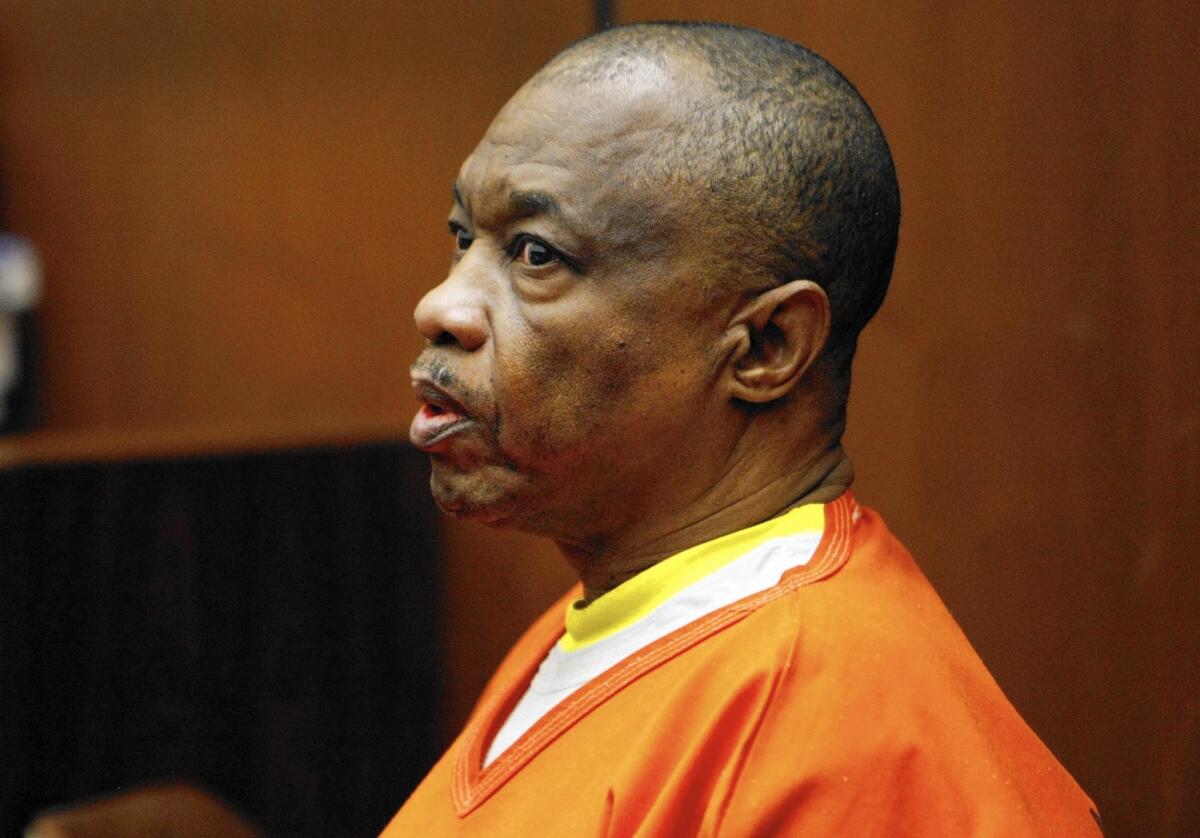Grim Sleeper defense says DNA in some cases points to another suspect

Lonnie Franklin Jr., who authorities say is the Grim Sleeper serial killer, answers questions from the witness stand in January 2014. His trial, which has been repeatedly postponed, is set to start in October.
- Share via
Since Los Angeles police first announced that they had made an arrest in the hunt for the so-called Grim Sleeper serial killer, the case involving the slayings of more than 10 women has centered around DNA.
Genetic evidence at the crime scenes helped investigators conclude they had a single killer. Authorities say tests matched the DNA profile to one man: Lonnie Franklin Jr.
But now Franklin’s attorneys are also making use of DNA, alleging that genetic material from another man was found on items collected at the crime scenes of three of the victims linked to their client.
“What role that person plays, we don’t know,” said defense lawyer Seymour Amster, who filed a 16-page motion last week detailing a defense expert’s finding about the new DNA profile. “But we believe he stands in the same equal status as Lonnie.”
Authorities say Franklin preyed on poor and vulnerable girls and women whose deaths spanned more than two decades beginning in 1985. He faces 10 counts of murder and one of attempted murder, but investigators believe he is responsible for more killings. Many of the victims were found along a South L.A. corridor straddling Western Avenue, and prosecutors contend that a combination of DNA and ballistics evidence links him to the crimes.
In the motion filed Wednesday, the defense attorneys also argued that the case against Franklin, now 62, is flawed because some of the evidence collected from decades-old crime scenes has since been destroyed.
The motion lists dozens of now-gone items: a dark-red carpet draped over one victim’s body, another victim’s brown leather jacket and white bra, and a sexual assault kit in another case.
Citing the missing evidence and the other DNA profile found at some of the crime scenes, the attorneys asked a judge to bar the prosecution from seeking the death penalty against Franklin.
“A man is being asked to defend his life without all the evidence to determine what the truth is,” Amster said. “That’s a problem.”
One of the prosecutors on the case, Deputy Dist. Atty. Beth Silverman, dismissed the defense’s claims, saying that destruction of evidence is far from unheard of in old cases. Silverman said she thinks the defense expert may be misinterpreting the DNA evidence in concluding that the genetic material links another person to three of the killings.
“I would be very surprised if this turns out to be true at the end of the day,” she said. “I have zero proof that this is true.”
Even if the evidence pointed to a second participant in the killings, it wouldn’t cripple the prosecution case, she said.
“That won’t lead to the exoneration of Lonnie Franklin,” she said. “There’s only one person in common in all of these cases.”
The 2010 break in the case — first dubbed the Grim Sleeper by the L.A. Weekly — came after a sweep of state offender records turned up a partial DNA match. The match didn’t belong to the serial killer suspect, but he was a close relative.
Police eventually homed in on the convict’s father, Franklin, and followed him to John’s Incredible Pizza in Buena Park in the summer of 2010, where they collected an unfinished slice of pizza and used it to analyze his DNA. It matched the genetic profile from the crime scenes.
The motion filed Wednesday said that the defense expert determined that a different person’s DNA was found on clothing and other items collected from the crime scenes of victims Barbara Ware and Lachrica Jefferson.
The motion also states that the same DNA profile was found on an item collected from the crime scene of a third woman, Georgia Mae Thomas, whose 2000 death has been linked by police to Franklin, though the victim isn’t listed in the criminal charges he is facing. The defense raised the possibility of the same profile being present at the scenes of more of the killings, saying the DNA expert has yet to complete his analysis.
The attorneys argue that the expert’s finding is a serious problem in light of the destroyed evidence, saying it limits the defense from determining if the other man’s DNA was at more of the crime scenes.
Officer Nuria Vanegas, a spokeswoman for the Los Angeles Police Department, said she couldn’t comment on evidence in the case, but added that sometimes “when the cases are really old and it’s been cold for a number of years, evidence is destroyed.”
The defense has taken aim at the DNA evidence in the case before.
At an earlier court hearing,Franklin’s attorneys argued that his DNA had been collected illegally at the pizzeria because an officer dressed as a busboy cleared his plate before he had finished eating. They argued that Franklin expected his plate to go into a trash pile and therefore didn’t expect his DNA to be available for testing.
A judge rejected the argument and ruled that it was obtained legally.
Twitter: @marisagerber
More to Read
Sign up for Essential California
The most important California stories and recommendations in your inbox every morning.
You may occasionally receive promotional content from the Los Angeles Times.











